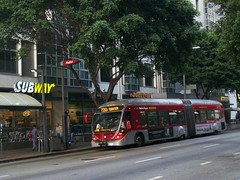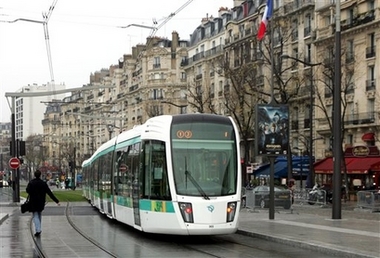A different opinion on BRT
comes from Maryland State Delegate Al Carr, in a blog entry on Cleveland's BRT, "Riding North America's Newest Transit Line." Delegate Carr is from Cleveland so I will grant he knows a lot more about Cleveland than I do. (Be sure to check out the many good photos in the entry.)
True BRT is different from any bus service offered in DC. The "Metro Rapid" service on Georgia Avenue is "limited stop" or "express" service, but is not BRT.
The definition of BRT service comes down to dedicated guideway, stations, pre-pay before boarding, branding and identity, and some other characteristics. Not all BRT systems have dedicated guideways, i.e., like Pittsburgh (which doesn't do prepay). The point of prepay, like with the subway, is that you don't waste time collecting money upon entry.
Except for a couple bus lines in North America, specifically in Los Angeles, the nation's second largest city, typical BRT ridership in U.S. settings comes nowhere near the ridership figures in DC, either for the subway, or for the 5-10 highest use buslines (mostly in DC proper).

Metro Rapid bus, Wilshire Blvd., Los Angeles.
Shouldn't we accept that the DC region has high transit ridership possibilities and opportunities and therefore plan robustly, rather than dink around (also known as satisficing)?
I think it's fine to explore BRT, but at the same time, let's not argue that it can do the job as well as fixed-rail transit.
And as this thread of entries is developing, it makes me think we need to think about light rail in some places instead of the streetcar, such as for H Street-K Street-M Street and maybe even from Dupont Circle to Laurel, Maryland via Rhode Island Avenue-Route 1--such a Rhode Island Light Rail line isn't being planned. Because these lines have the capacity to deliver many longer trips and compete favorably with the automobile to divert riders from cars to transit.

A car of the new Paris tramway is seen at Porte de Versailles, South of Paris, shortly after its inauguration in Paris, Saturday Dec. 16, 2006. The tram will transport some 100,000 travelers a day to and from the southwest area of Paris. (AP Photo/Remy de la Mauviniere)
Paris has added light rail lines (trams) to its fixed rail transit network. The city is served by the underground subway as well as some railroad service, in addition to the tram system and buses.
------------------
Note that the VIVA system in York Region, Toronto, has about 66,000 daily riders on 4 lines, and has seen transit adjacent development, although they do specifically plan BRT as leading to light rail, not a replacement for it.
See Presentations from York Region Transit on their Viva BRT, from a briefing at the recent APTA BRT Standards Committee:
* Intro & Service
* Facilities & Fleet
* Marketing
* TMS
From the Bus Rapid Transit Policy Center website.

Labels: bus rapid transit, transportation planning



0 Comments:
Post a Comment
<< Home